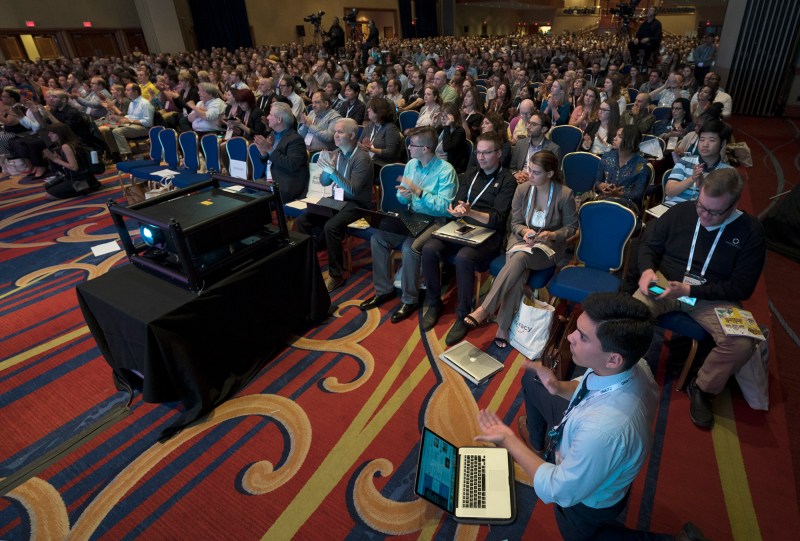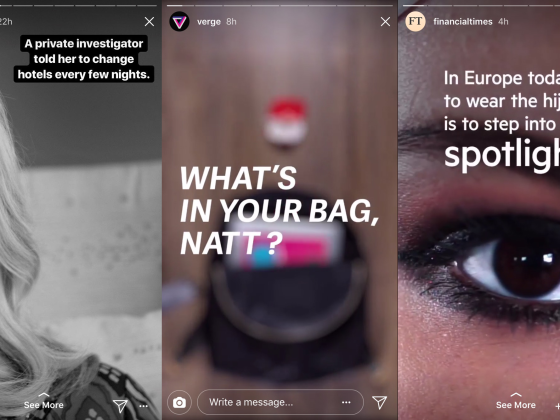The Online News Association’s ONA17 conference hit record attendance numbers in Washington, D.C. this week, which wasn’t hard to see.
Journalists crowded the sessions and poured out into the hallways, and the line for the coffee station snaked around the lobby.
About 3,000 people attended ONA17 because organizers added 800 more registrations over last year. In Denver, 2,200 people attended. That decision came down to the venue size and safety, said Trevor Knoblich, ONA’s Head of Programs and Events.
That jump in attendance isn’t unusual.
Since 2014, attendance has increased by about 69 percent as ONA officials have added more registrations. More than 1,700 people attended ONA14 in Chicago. And when ONA held its first conference in New York City in 2000, attendance was in the hundreds. In two decades, those who attend annual gathering have gone from a merry band of outsiders to the cool kids.
Opening the door to a sitting room only panel at #ONA17 pic.twitter.com/FsHah7IaW1
— Dom (@DomDiFurio) October 6, 2017
But is bigger always better?
For the most part, journalists at the conference say yes. They say a large crowd affirms the importance of online journalism and provides a bevy of folks to meet. Still, many reported that they could not get into the panels they wanted to attend because they filled up too quickly.

“It definitely feels bigger to me. I feel like the sessions are a lot more crowded, and it’s great because I’m getting to meet a lot of people,” said Palm Beach Post reporter Kristina Webb. “But at the same time, every hallway is so overwhelmed. You’re kind of elbowing your way to get to your session.”
It was a challenge to get into the popular sessions early enough to get a seat. Even those who arrived 15 minutes early weren’t guaranteed a spot in the room.
“I think there are benefits to it being bigger. Obviously, you’re going to get to meet more people. Your networking opportunities are broad, but at the same time, a lot of the sessions that I’ve tried to get into are filling up 20 minutes before the session starts,” Webb said. “Girl has got to go to the bathroom, so every once in a while, I’m not going to make it there 20 minutes before the session starts, so that has been a real downside.”
The rooms may feel crowded, but they’re significantly larger than last year. The largest room at ONA16 in Denver could accommodate 180 people. This year, Knoblich said, the smallest room holds 240 people.
“This hotel can do more,” Knoblich said. “It’s a bigger hotel than last year.”
Additionally, Knoblich said ONA is holding focus groups throughout the conference to determine what attendees like and what they don’t to inform planning for last year.
Fiza Pirani, a reporter at The Atlanta Journal Constitution, is at ONA for the third time. She said ONA17 feels the largest conference so far, and she noticed sessions on the second day of the conference were overflowing. Many attendees sat on the floor, she said. Despite the crowd, Pirani said she’s excited to see so many newsrooms engaging with new approaches to online news.
“The crowds are worth it because here we aren’t competing. We’re all in it together,” Pirani said.

And Joel Shannon of USA Today said he’s been drawn to those large, crowded sessions.
“Those bigger sessions for the most part were the ones I got the most of. I was familiar with the work. One of the cons is that you can’t come in late to a session. My editor used to float in and out, and you couldn’t do that this year,” Shannon said.
Independent journalist Flavius Mihaies disagreed. He’s noticed fewer lines and said packed panels are just part of the conference experience.
“There have always been long lines for drinks and stuff. There are less lines this year I feel. This is more spacious than Denver and LA. For the non-recorded panels, the room is tight, but that’s just how it is. [The conference is] spacious and doesn’t feel more crowded at all,” Mihaies said.
The Denver-based mixologist whipping up cocktails at the CNN booth estimates he served 400 cocktails by 3 p.m. on Thursday, the first day of the conference.
“Apparently journalists like to drink,” Dylan Holcomb said with a laugh. “That’s something I learned: Journalists enjoy a good cocktail.”
Mihaies, who also works as a consultant at the World Bank Group, suspects ONA is more crowded this year in reaction to the 2016 election.
“I think there is more gravity and sense of responsibility after the elections. Journalists have always had a sense of mission, but we say it more now,” Mihaies said.
Standing room only for @mhess4, @jacqueboltik and @Matt_Kiser‘s newsletter panel! #ona17 pic.twitter.com/HdG2qeDOg9
— Meena Thiruvengadam (@Meena_Thiru) October 5, 2017
Emily Tan is a web producer for Simons Foundation in New York and an ONA first-timer. She does not have a frame of reference for the size of the conference like veterans do, but the crowd was hard to miss.
“Today was the crazy thing. Every engagement and analytics session was packed,” Tan said. “I went to a Table Talks and there was no room at the table. There was a line to get into The Midway and it felt like I was trying to get into a club.”
ESPN’s Justin Ellis spoke on the “The Art of Getting Sh—t Done” panel and was surprised to see folks sitting on the floor and standing against the wall during his session. He’s been to seven ONA conferences and noticed a “broader” group of people at ONA17.
Former ONA16 volunteer Kimberly Spencer of the Public News Service agreed Ellis’ panel was crowded, but she said the conference doesn’t feel much larger overall compared to ONA16.
For Denise-Marie Ordway, the size of the conference wasn’t a problem, though she wonders if ONA is growing faster than organizers anticipated.
“It’s so packed, and I mean it’s wonderful because it’s growing and it’s fabulous, but I think it’s growing in a way that they haven’t planned for, so that’s the frustration about how people couldn’t get in the sessions,” Ordway said.
“Bigger means greater diversity and number of sessions so I like that. That means you got to know people from a lot of different places, lots of different backgrounds, I love that, so bigger in all, is better, I am just wondering if it’s growing a little bit faster than it planned.”
Crowd shot for the packed room — talking ethics w/ @NPR#npr2017ona#ONA17 ready! pic.twitter.com/cT9EljHcc5
— Sara Kehaulani Goo (@sarakgoo) October 6, 2017
ONA Student Newsroom journalists Alan Hovorka, Alicia Wilson, Caitlin Ostroff, Christian Monterossa, Elaine Zhang, Kenny Jacoby, Peyton Chance, Starla Sampaco, Haley Samsel, Jacquelyn Elias, James Tyner and Alma Washington contributed to this story.







You must be logged in to post a comment.